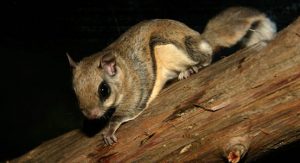Marcy’s Woods is ecologically significant for the variety of animals considered to be nationally vulnerable species (animals that are special concern due to their biology and habitat that put them at risk of population decline due to human activities or ecological events).
Southern Flying Squirrel
Southern flying squirrels are a special concern both provincially and nationally and are protected under the Fish and Wildlife Conservation Act as a species at risk. The number of southern flying squirrels is in rapid decline due to human encroachment and interference on their habitat. In spite of the limited total population of the southern flying squirrel, the largest and most stable population of these cryptic, nocturnal mammals appears to inhabit all of the major forest habitats of Marcy’s Woods.
Bird Species
Point Abino and Marcy’s Woods is a prime stop over for migrating land birds and has been a key location for Bird Studies Canada to inventory and track the various species. The areas that combine to create Marcy’s Woods are inhabited by distinct bird species. In total, 85 species including the Red-bellied woodpecker, pileated woodpecker, yellow throated vireo, red breasted nuthatch, blue-winged warbler, northern parula, hooded warbler, and the black-throated green warbler can be spotted on the precious land.
The woodland species of Marcy’s Woods including the Red-headed woodpecker, Cerulean Warbler, and Hooded have been designated by the Committee on the Status of Wildlife in Canada (COSEWIC) as being nationally vulnerable.
The older growth upland forest and second growth swamp forest is dominated by Baltimore Oriole, Red-eyed Vireo, American Robin, Black-capped Chickadee, Wood Thrush, Blue Jay, Easter Wood-Pewee, Verry, Great Crested Flycatcher, and Brown Headed Cowbird. These birds are common in southern Ontario’s deciduous forest although the extremely high number of orioles is unusual.
Open area (meadows) birds comprised of Yellow Warbler, Gray Catbird, Song Sparrow, Red-winged Blackbird, and the Common Yellowthroat are typical in comparable habitats in southern Ontario.
Additional Wildlife
Marcy’s Woods is home to a variety of species which also includes the eastern redback salamander, American toad, green frog, northern leopard frog, bullfrog, opossum, gray fox and the Woodhouse Toad.
The Woodhouse Toad is another example of Marcy’s Woods ecological importance as this toad is nationally, provincially and regionally rare, but continues to thrive in Marcy’s Woods.

